As this is my first opportunity to write for 10,000 Birds I thought I might introduce you to my “beat”, and perhaps some of the birds in it. Arctic Canada.
Arctic Canada… Arctic… Canada…
Okay, first thing you need to know is it is a really big place. Really big. I live in one of Canada’s three northern territories, the newest one: Nunavut. Nunavut is encompassed entirely in the Arctic. The other two territories, the Northwest Territories and the Yukon also form part of Arctic Canada. How much depends on one’s definition of the Arctic, and there are many. Some use any area lying above the 60th parallel, some the Tree Limit, some the limit of contiguous permafrost. Some hard core people define it as the lands above the Arctic Circle, 66 2/3 degrees north, the point on the earth that has at least one day a year where the sun doesn’t set, and one day when it doesn’t rise.
But by what ever measure one uses, it is a massive amount of land and sea. Nunavut, my home for the last eleven plus years, has a land mass of over two million square kilometres. That is over one fifth of Canada’s total land mass. In fact if Nunavut was a country, in terms of land mass, it would be the 14th largest country in the world.
So we have a lot of land, but what we don’t have is a lot of people. Our population is less than 30,000. That’s less than, say, Fairbanks, Alaska. And those two factors, huge area that is extremely sparsely populated, make for a very interesting opportunity for bird enthusiasts, such as myself. A large area with few people, and even fewer birders, means there are great gaps in our knowledge of birds up here, especially in the realm of populations and breeding data. It gives an opportunity for even someone like myself, with mediocre birding skills, to add to the data pool, sometimes significantly. Programs such as the NWT/Nunavut checklist program and eBird allow me to contribute. Because there is such little data, every little bit becomes even more important.
Now we get some amazing birds up here. Birds that few people in North American get to see, or get to see in their breeding finery. Just not this time of the year. Where I live, an amazingly beautiful corner of the world called Arctic Bay, the winter isn’t very bird friendly.
I live some 700 kilometres NORTH of the Arctic Circle, at 73 degrees north. The sun set here on November 5th, and unless I travel south I’ll not see it again until February 6th. As I write this (about 2 hours before my deadline) it is an unseasonably warm -7 degrees Celsius (19 F), but the wind is gusting upwards of 80 kms/hr (50 mph). Normally temperatures this time of year are in the minus 30s, and usually it is calmer in these parts.
I’ll not see any migrants up here until May, and the big rush of breeding migrants comes in early June. This time of year I am pretty much assured of seeing one species of bird. Luckily it is one of my favourite birds, my constant companion, the Raven.
Common Raven
There are others though, this is turning out to be a great year for redpolls, mostly Hoary Redpolls which, surprisingly, is a year round resident of the High Arctic. Then there are ptarmigan (almost exclusively Rock Ptarmigan in the neighbourhood, although Willow Ptarmigan are also a possibility). And thanks to the keen observations of some friends of mine up here we know that at least some Gryfalcon winter here, rather than farther south as conventional wisdom has told us.
Rock Ptarmigan
Female Gyrfalcon
And that pretty much rounds up the usual (winter) suspects. But don’t despair, spring and summer brings birds close by that many of you would drive a long way to see. Breeding plumage Red Phalaropes, Ivory Gulls, Ross’ Gulls, Sabine’s Gulls, Lapland Longspurs with their singing flights and gorgeous plumage, Black Guillemots, Thick-billed Murres, Red-throated Loons, Pacific Loons, Yellow-billed Loons and many others. In all of Nunavut, the total species count is a little more than 200. But many of those species were observed in our southern fringes. Up here fifty species would be an amazing count. But what glorious birds they all are.
Female Red Phalarope
Red-throated Loon pair

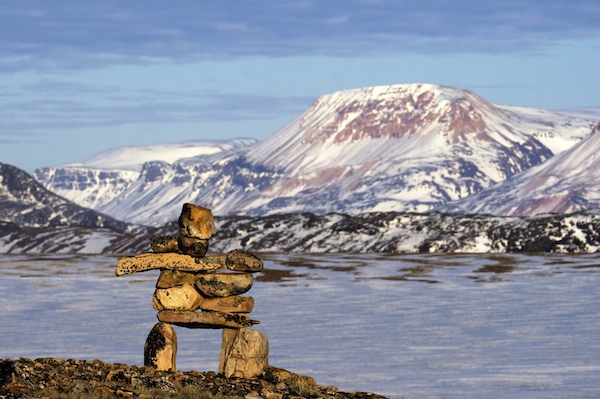
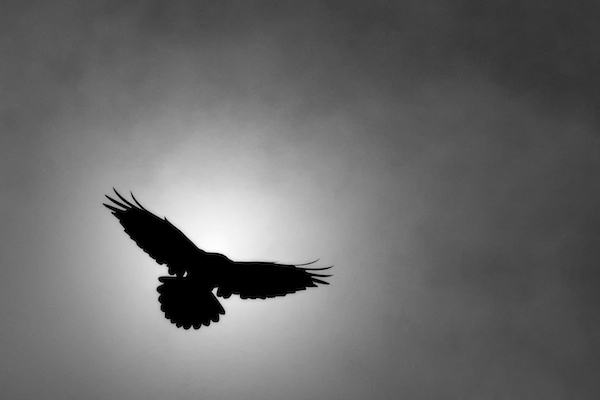
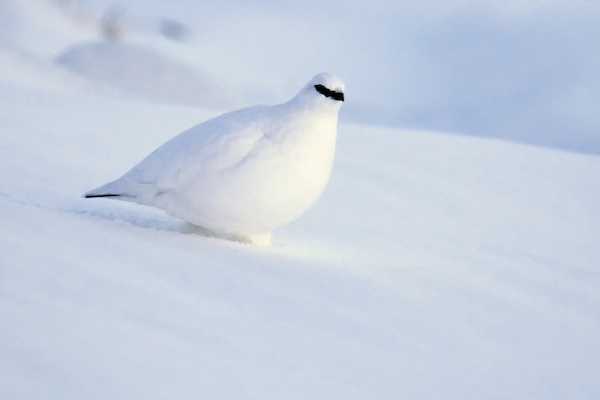
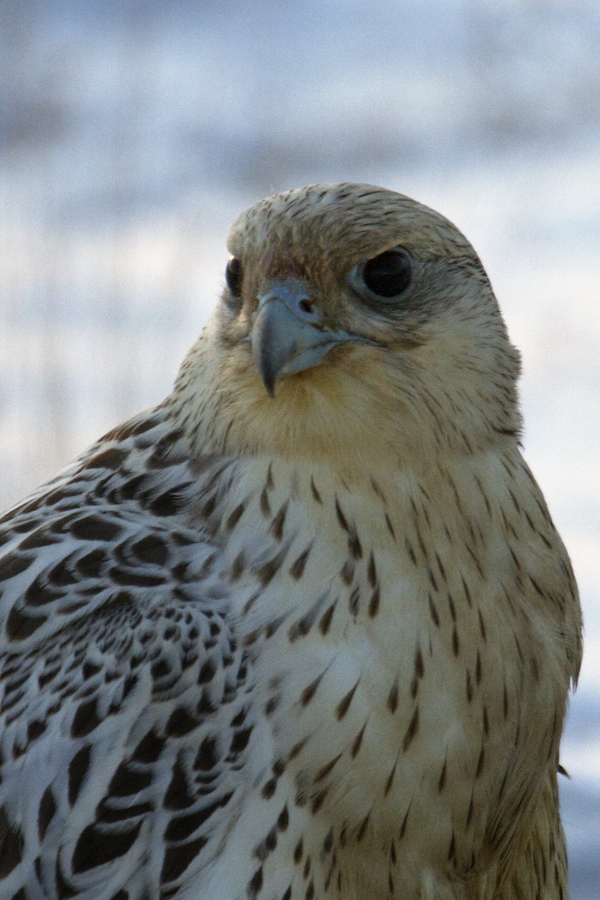
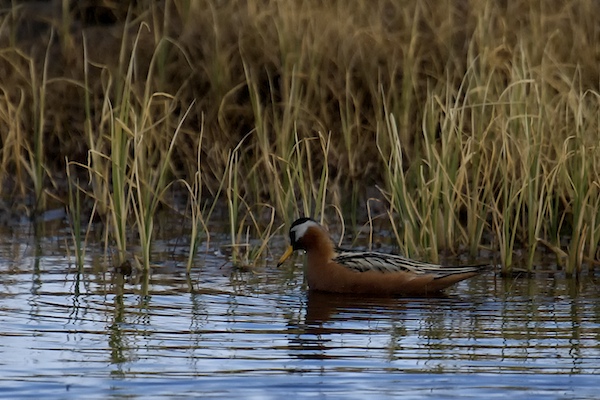
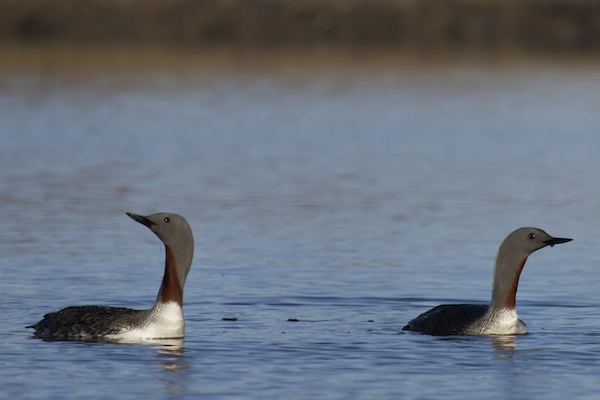










Great article! The Rock Ptarmigan is such a beautiful bird!!
Félicitations Clare. La glace est brisée et continue à nous charmer avec tes intéressantes articles. Robert Tailleur
Wonderful first post, Clare. It is an especially delightful treat to see the birds in your neck of the woods.
Great intro to your world… I will look forward to hearing more about it. Great pics, too. I am still trying to understand how you can get through a winter where you will not get ANY sunlight until Feb!!
Great first post. Beautiful photo with the water, mountain and the magnificent inukshuk is a great intro. Congratulations, Clare!
Stunning post and place. I look forward to more of the same. Thanks
@cindy… they certainly are beautiful birds. This one was taken on Valentines Day in a canyon about 20 kms from town.
@Robert… Merci Robert. Je l’essaierai.
@Robin… Thank you. Wish you could come see them in person
@Jean… while we don’t see the sun, we have a varying amount of twilight each day. It is never completely dark. Even on Dec 21st you cannot see stars at noon. And we get 24 hour light before we get 24 hour sun.
@Pam… Thank you very much
@Renato… Thanks. It is very much a magical place.
WOW! so distant and so different of what I’m used (OK, I live in tropical Panama). And those birds are simply beautiful!
We can’t imagine cold weather! 29c minimum last night and just a fan on low, as I think we have thin blood from living in the tropics! No wonder our birds put on so much weight before they go north-not just for the journey, but to keep warm when they get there! We see shorebirds come back with frost bitten toes here. Looking forward to more about the Arctic-thanks.
Hello Clare. What an amazing writer you are and what a treat it is to have found you! I saw a reference for your blog in my Canadian Living magazine and I HAD to check it out. My neighbour’s 23 year-old son is in Hall Beach, Nunavut helping establish some building projects. Naturally, I am interested in life “in the North” and though I don’t receive any communication from my neighbour’s son, reading your blog has helped me to ‘see’ and ‘feel’ the north. You have made it sound so very beautiful and the pictures confirm it. Thank you for your efforts! I love our country. The true, North, strong and free. Write on!
Awesome to see Clare on 10,000 Birds, he is one of my favorite bloggers of all time!
@Jan – Perhaps we should arrange a swap for a bit. I’d get to see your beautiful birds and you’d get to see mine.
@Clare and Graham – Our summers usually hover around 8 or 10 degrees. 13 would be considered a very hot day. Take care of our birds while they’re down there, can’t wait to see them again in OUR summer. And what a lovely name you have.
@ Carol – Thank you. Hall Beach is just down the road, so to speak, 300 kms or so away. My in-laws snowmobile there almost every spring and one of these days I’m going to have to make that journey.
@ Will – Why thank you very much Will.
This is a great article, Clare. I read your blog regularly. Nice to see you at 10,000 Birds. Very beautiful photos.
Thanks Kathy. Nice to connect to another blog from Saskatchewan. Go ‘Riders!
Very interesting post. I agree with Will, you are difinitely one of my favorite blogger. Plus you rapresent for me one of the best way to feel and axplore the great north, since I live far away.. in Italy (but I LOVE the Artic..).
Hope one day to come to your bad and breakfast for a long holiday. (I’m seriously considering about it).
Keep going like this !
Thank you Nick. Would love to see you in the Arctic. Unfortunately we no longer own the Bed and Breakfast, having lost it to our mortgagor a year ago.
Thanks to you Clare. oh,I’m sorry, I should have red your blog better, you probably wrote about that.That’s too bad. I discovered the blog not a long time ago and I’ve still to explore it a bit(anyway in one month or so since I discovered it I red a lot of it). Very well written,super interesting at least for me, superbe pics. I’m pretty much interested in everything you write since nature, wildlife , Artic in general, are among my major interests,as well as people who inhabits it..oddly enough for me living on the other side of the world and waaay south in a completely different climate).
Anyway, I will travel to Edmonton quite often in the near future having relatives there .One day for sure I will find the time, I ‘ll manage to come up north one day .I hope to find you in Artic bay and to have the pleasure to have you as a guide for a birdwatching tour. You’re soo good at it, even on the “virtual artic tours” I do reading your beautiful blog !
Nick
Not a problem Nick. There are worse things that can happen to one in one’s life. Thank you once again for your kind words.
Absolutely right, I agree Clare. I look forward to the end of the next month to admire some new interesting Artic bird pics! I would imagine in this time of year you can find ravens and a couple of species of ptarmigans,(possibly some rare giryfalcons?)in Artic bay surroundings, am I right?
Beside the cold (I know those species can withstand it very well), I wonder how do they adapt themselves to the permanent winter darkness and how could you find them in it to take pics. It’s intriguing.
sorry for my english, it’s been a long time for me not writing or speaking it.
ops I did a mistake, giryfalcon is certainly not overwintering there.